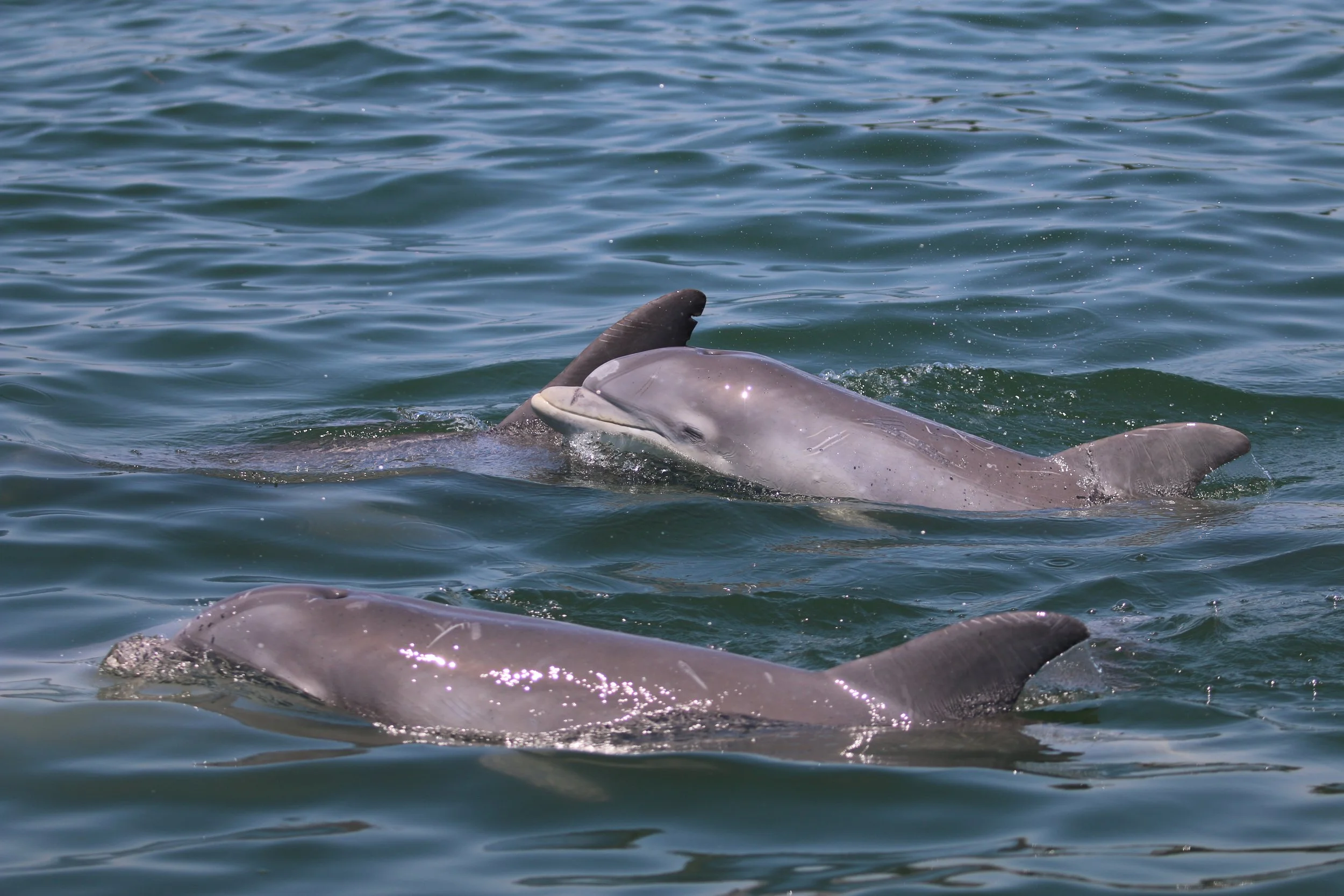In this Common Home Magazine article, Dr. Janet Mann describes how house hunting in Virginia led her to start the first research project on the dolphins inhabiting the Potomac River and Chesapeake Bay. She also discusses current research our lab members are conducting and the contributions by the Earth Commons in supporting our work.
Tracking the Impact of Offshore Construction on Chesapeake Bay Dolphins Using Sound Data
Through the use of hydrophones, a technology which records underwater sounds, researchers of the PCDP and Chesapeake DolphinWatch have begun to understand how the construction of offshore wind turbines affects the dolphin population in this area. Read more about this topic in Chesapeake Bay Magazine’s recent article.
Dr. Janet Mann's Path to Dolphin Research
As part of Georgetown University’s “Beyond the CV” blog series, PCPD Director Dr. Janet Mann is interviewed on how dolphins became her passion, why they are so interesting to study, and some highlights of her research thus far. Explore the full feature here.
Recognizing Individual Dolphins Linked to Increased Empathy and Conservation Efforts
A newly published article by Georgetown University postdoctoral fellow Pauline Smith and Georgetown professors Dr. Janet Mann and Dr. Abigail Marsh dives into the intersection between human psychology and environmental conservation. Specifically, Smith et al. inspect whether the tendency for humans to exhibit greater empathy towards recognizable individuals is applicable to individual dolphins, and if this recognition causes an increased desire to take conservation action. Using photographs of Tamanend’s bottlenose dolphins collected by the PCDP, study participants were tested on their ability to recognize individuals and specific empathetic reactions towards them. The results showed that a greater ability to recognize an individual dolphin is correlated with higher empathy, as well as an increased enthusiasm to participate in real-world environmental actions. Additionally, pairing a photo of an injured dolphin with a narrative describing the injury led to an increased willingness to donate to a conservation organization. This is the first study that has examined the relationship between human recognition of individual wild animals and whether this can increase sustainable behaviors. The ability of non-expert individuals to recognize and feel empathy towards animals is important in the field of conservation because, as demonstrated in this article, it can lead to more altruistic behavior and therefore improved environmental action.
Understanding the Presence of Dolphins in the Chesapeake Bay
Recently, there has been growing debate about whether the increased presence of dolphins in the Chesapeake Bay signifies improved water quality. The Baltimore Sun’s Dan Rodricks discusses with the PCDP’s Ann-Marie Jacoby why this might not be the case. With only seven years of data on this dolphin population, we can’t assume that the population is increasing despite high numbers of dolphins being sighted. Jacoby’s research focuses on gathering historical information on these dolphins and has found through different media that this dolphin population has been in the area for a long time.
Read the full story here.
Smithsonian Ocean Feature on PCDP Research
The Smithsonian National Museum of Natural History’s Ocean Portal describes the PCDP’s key research and findings, including the historical presence of dolphins in the Potomac, the spread of disease in this population, and what we have yet to learn about these animals.
PCDP Research Featured in "Sex in Cetaceans" Textbook
Check it out, pages 210-211.
Dr. Janet Mann Interviewed on Eagle Haven Podcast
Dr. Janet Mann has a conversation with Dr. Julie Boyle about Mann’s research on dolphin social networks, communication, and tool use.
PCDP Researchers Publish Paper on Barnacle Infestation on Cetaceans
PCDP alumni lab assistant Milan Dolezal along with PCDP Director Dr. Janet Mann, Associate Director Ann-Marie Jacoby, Project Member Melissa Collier, and Lab Assistant Colin Murphy, published an article focused on the impact of temperature and hydrodynamics on the growth of the barnacle species Xenobalanus globicipitis on cetaceans. Dolezal et al. found that both of these factors impact the location of attachment of X. globicipitis on the dorsal fin. These results indicate that with global warning and rising sea surface temperatures, the infestation of these barnacles on cetaceans will be more common due to their affinity for warmer temperatures.
Check out the article here.
Chesapeake Dolphins Thrill Spotters, Scientists
The Bay Journal describes the Chesapeake DolphinWatch program and the PCDP’s contributions to understanding the local dolphins.
AP News on the Intersection of Social Behaviors and Disease Spread in Dolphins
AP News journalists joined PCDP researchers for dolphin sightings and to discuss the importance of understanding the social bonds and behaviors in dolphins to understand disease transmission in a population. Read the article here.
Bay Journal on the Increase in the Potomac Dolphin Population
Whitney Pipkin of the Bay Journal discusses the recent resurgence of the dolphin population in the Potomac and the researchers studying these animals, including the PCDP and Chesapeake DolphinWatch.
Check out their more recent feature on the Potomac dolphins here.
Dolphins Are One of the Animals You May Be Surprised to See in the Potomac
The Washingtonian mentions the PCDP’s study of the Potomac dolphins!
Earth Island Journal Features PCDP
The Earth Island Journal discusses the PCDP’s work and the current state of dolphins in the Potomac River. Check it out here!
Dolphin population growing in Potomac River
The Georgetown Voice writes a feature on the PCDP, describing our current research and what their presence can tell us.
WAMU feature on the Potomac-Chesapeake Dolphin Project
Hear about our work on Kojo Nnamdi, WAMU
Director and Founder of the PCDP, Dr. Janet Mann, talked with the host alongside the President of the Potomac Conservancy, about the significance of the dolphins’ return to the Potomac.
Dolphins’ Return to Potomac River Suggests Improvement of Water Quality
Author Jason Daley from Smithsonian Magazine discusses the repopulation of dolphins in the Potomac River after 50 years of restoration efforts.
Read more on this topic:
Potomac Conservancy Joins PCDP Researchers for Some Dolphin Spotting
Potomac Conservancy’s Communications Manager, Willis Kliefoth, came aboard the “Ahoya” for an update on our research and to spot some dolphins.
PCDP Researchers Document the First Evidence that Dolphins Give Birth in the Potomac!
On August 17th, PCDP researchers witnessed evidence of a dolphin birth! Learn more about the event in the articles below!
Patsy Mink and her newborn calf, Gwendolyn Mink. Taken under NOAA NMFS Permit No. 19403, PCDP
Name the Dolphins Campaign with the Potomac Conservancy
This spring and summer, the PCDP collaborated with the Potomac Conservancy to have a naming contest, allowing the public to name two of our frequently sighted dolphins. This resulted in considerable press and competition to name the dolphins!
The punchline- “Mac” and “Chessie” won (visit https://potomac.org/name-potomac-dolphins). Stay tuned to learn more about them.
Here are the stories….
May 2019
June 2019



















